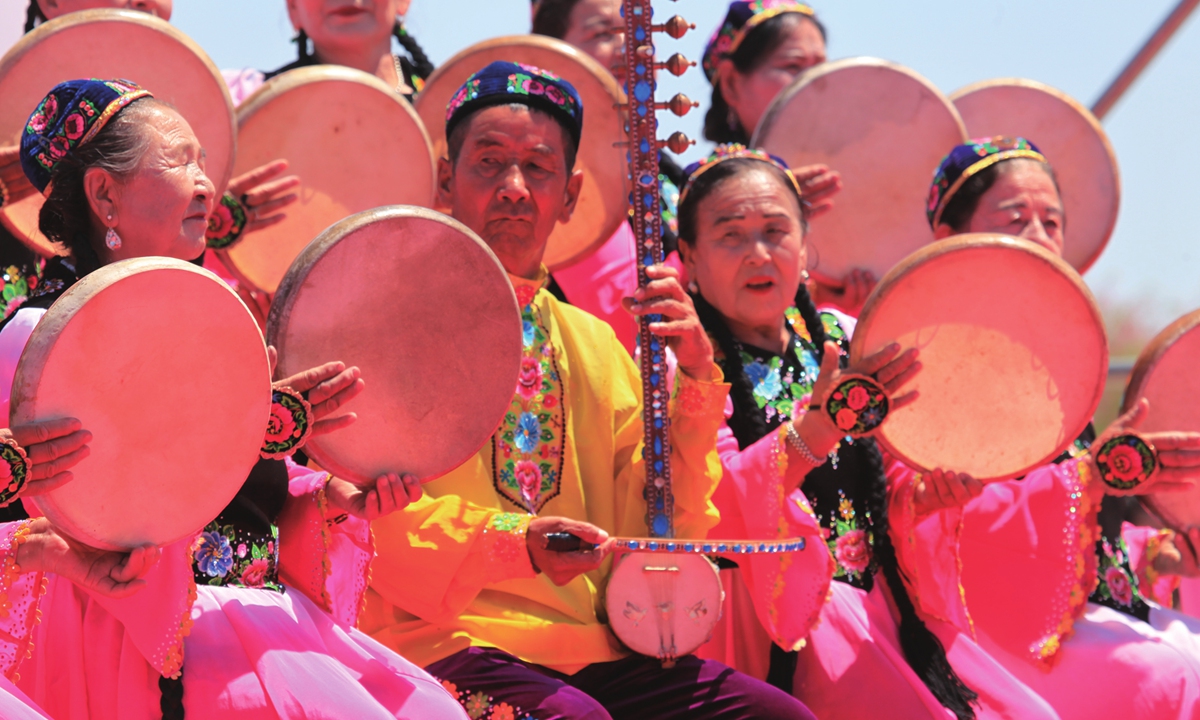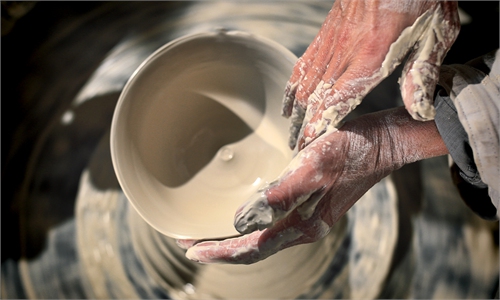The Uygur Muqam in Xinjiang
The Uygur Muqam is a comprehensive art form popular in Northwest China's Xinjiang Uygur Autonomous Region. It features singing, dancing, folk and classic music, literature and theater that are performed either solos or in groups.
Originating from the Western Regions during China's Han Dynasty (206BC-AD220), the Uygur Muqam was established between the 9th and the 14th centuries and matured in the 16th century. Due to its location along the ancient Silk Road where the East met the West, the Uygur Muqam was influenced by Asian, African, Persian and Arabic forms of Muqam.
In the modern Uygur language, Muqam means "classic music,""standard" and "melody." It is composed of 12 parts with each of them consisting of three sections, including ensemble (Naghma), epic (Dastan), and folk songs and dances (Mashrap). The Twelve Muqams are the most representative work of the Uygur Muqam. Comprising about 30 songs, each of them sung or played for two hours, a performance of the Twelve Muqams in its entirety can take more than 20 hours. Boasting lively and rhythmic music, joyful dances and fluent narratives, it has become a cultural treasure of the Chinese nation.
In the 1940s, the Twelve Muqams were on the brink of extinction as very few artists could perform a complete set. After the People's Republic of China was founded in 1949, the Chinese government attached great importance to protecting this cultural heritage by looking for veteran artists and recording complete sets of narrative and melodies. In 1960, the Twelve Muqams were officially published, including 340 classic epics, folk ensembles, dance music and improvisational music. After China's reform and opening-up was adopted in 1978, the government of the Xinjiang Uygur Autonomous Region has made greater efforts to collect and compile this ethnic cultural work.
In recent years, the booming pop music and urbanization trends in Xinjiang had a strong impact on the traditional culture of the Uygur Muqam. To better protect it, the Uygur Muqam was registered on the UNESCO Representative List of the Intangible Cultural Heritage of Humanity in 2008 and listed in China as a national intangible cultural heritage in 2016.

The Uygur Muqam is a comprehensive art form popular in Northwest China's Xinjiang Uygur Autonomous Region. It features singing, dancing, folk and classic music, literature and theater that are performed either solos or in groups.
Originating from the Western Regions during China's Han Dynasty (206BC-AD220), the Uygur Muqam was established between the 9th and the 14th centuries and matured in the 16th century. Due to its location along the ancient Silk Road where the East met the West, the Uygur Muqam was influenced by Asian, African, Persian and Arabic forms of Muqam.
In the modern Uygur language, Muqam means "classic music,""standard" and "melody." It is composed of 12 parts with each of them consisting of three sections, including ensemble (Naghma), epic (Dastan), and folk songs and dances (Mashrap). The Twelve Muqams are the most representative work of the Uygur Muqam. Comprising about 30 songs, each of them sung or played for two hours, a performance of the Twelve Muqams in its entirety can take more than 20 hours. Boasting lively and rhythmic music, joyful dances and fluent narratives, it has become a cultural treasure of the Chinese nation.
In the 1940s, the Twelve Muqams were on the brink of extinction as very few artists could perform a complete set. After the People's Republic of China was founded in 1949, the Chinese government attached great importance to protecting this cultural heritage by looking for veteran artists and recording complete sets of narrative and melodies. In 1960, the Twelve Muqams were officially published, including 340 classic epics, folk ensembles, dance music and improvisational music. After China's reform and opening-up was adopted in 1978, the government of the Xinjiang Uygur Autonomous Region has made greater efforts to collect and compile this ethnic cultural work.
In recent years, the booming pop music and urbanization trends in Xinjiang had a strong impact on the traditional culture of the Uygur Muqam. To better protect it, the Uygur Muqam was registered on the UNESCO Representative List of the Intangible Cultural Heritage of Humanity in 2008 and listed in China as a national intangible cultural heritage in 2016.

Uygur entertainers perform the Uygur Muqam in Yiwu county, Northwest China's Xinjiang Uygur Autonomous Region on June 12, 2022. Photo: IC


